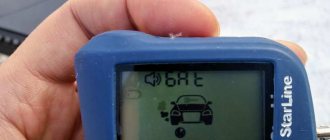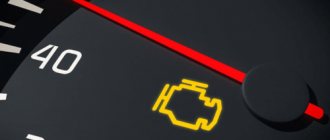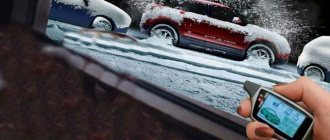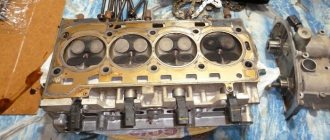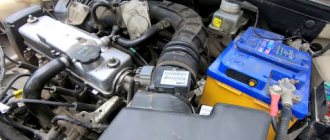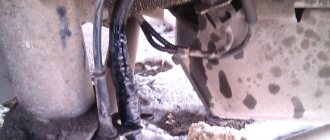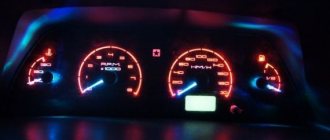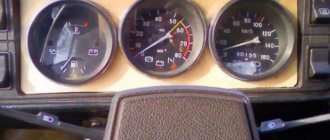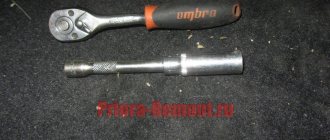There is an interesting icon on the Priora instrument panel. Upon closer examination, it is clear that this is the silhouette of a car engine. Every experienced driver, looking at him, will casually say, “Ahhh, Check.” But at the same time he will not be able to clearly explain what kind of “Chek” this is, and what it serves and why it caught fire.
You can hear many interesting versions. The most common one is that if it lights up, this is a signal of a breakdown of the mass air flow sensor (mass air flow sensor). Well, and a dozen more equally exotic versions. So what is this alarm? And in what cases does it light up? And most importantly, what to do in this case?
Checking the oil level and condition
The next most important reasons for the signal are considered to be overheating of the motor and a decrease in the level of lubricating fluid in the internal combustion engine. It is recommended to check the engine temperature. If there is no overheating, you need to check the volume and condition of the oil. After checking the level, it is necessary to add the missing amount of lubricant. Using a clean paper napkin, the quality and composition of the engine oil is checked according to the following criteria:
- Color.
- Consistency.
- Presence of mechanical inclusions.
- The smell of burning.
If everything is in order with the quality and quantity of oil, the engine starts to eliminate unusual sounds and noise when operating both at idle and under load.
If unusual noise effects of a running engine are detected against the background of a burning check, it is recommended to send the car to the nearest service company. Moving the car yourself is not recommended; delivery is carried out by towing or other convenient method. Further operation can lead to serious damage and costly repairs to the elements of the power unit.
Diagnostics of VAZ 2109, 2110, 2114, 2115, Kalina, Priora, Granta
Let's look at misfires using the example of the VAZ 2109, 2110, 2114, 2115, Kalina, Priora, Granta models.
The computer generated error P0303 (misfire in 3rd crank).
First you need to understand how the ignition coil works. It consists of two small coils, pins 1 and 4 are connected to the first, and pins 2 and 3 to the second.
Those. during operation, voltage is simultaneously supplied to the first and fourth cylinders or to the second and third.
We have misfires in cylinder 3. Remove the wires from 2 and 3 and swap them.
Start the engine and see if the error has moved to cylinder 2, then the problem is most likely in the high-voltage wires or in the coil itself, and they need to be checked first.
High-voltage wires are tested by checking their resistance. To do this you need a regular multimeter.
Set the resistance measurement mode to 20 kOhm.
In our case, we check the third wire. If the device shows numbers within the range of 3.5 - 10 kOhm, then the wire resistance is considered normal, otherwise it changes.
Next we check the coil. For this you also need a multimeter.
We measure the resistance between 1 and 4 and 2 and 3 coil terminals. Readings of 10 kOhm, or around this figure, are considered standard.
Important. During testing, the tester should not show 1. This means that there is an open circuit in the circuit and the coil is faulty.
Next we check the resistance between each terminal and ground. In this case, on the contrary, the multimeter should show 1 (infinity).
If resistance is shown at one of the terminals, it means that its insulation is damaged and it is connecting to ground. Accordingly, the required voltage will not be supplied to form a spark.
Next, we check the resistance between the central terminal of the ignition coil and the housing (ground). It should also be equal to infinity, i.e. 1.
Now it remains to check the resistance between the extreme terminals. To do this, set a different measurement range on the device - 200 Ohms.
A resistance of 2 ohms is considered normal (-). There should be no break between the extreme terminals.
- Next, check the condition of the contacts on the coil itself and on the wires; they tend to oxidize over time, especially if your region of residence has a humid climate.
- If the error remains in cylinder 3, but the coil and high-voltage wires are in good condition, we check the spark plug.
- The easiest option is to remove the spark plug from the working cylinder and swap them.
- If the error then transferred to another cylinder, then most likely the issue is in the spark plug.
- If nothing has changed and the error remains, then check the injectors.
In this case, you also need a multimeter. Disconnect the wires from the injector, in our case from cylinder 3, and measure the resistance, it should be about 13 ohms.
Next, check the injector power supply circuit. Also, the injector may become clogged and not supply the required amount of fuel, which can cause misfires. Therefore, you will have to clean the injectors.
If after all the above checks the misfires have not disappeared, you need to check the valve clearances.
The valves should not be tightly clamped, as this will lead to their incomplete closing, and this, in turn, will lead to a decrease in compression and compression ratio in the cylinders and this will cause misfires. Also, if you press too hard, the valve may burn out.
Error code: ecuExplorer - program for diagnosing Subaru » Do-it-yourself car repair, tuning and diagnostics
Especially the condition of the valves should be paid to owners of cars with LPG, since the combustion temperature of gas there is slightly higher than gasoline and therefore the thermal clearances of the valves in this case should be slightly larger, i.e. not 0.2, but 0.25 mm. And where is 0.3, then 0.35 mm (for the above models).
POPULAR WITH READERS: Tolerances and specifications of motor oils
READ ON THE TOPIC: Other characteristic malfunctions of the VAZ 2110 and other cars in the series.
Signs
How do you know if the engine is leaking? With such a malfunction, the check engine light does not always flash. Therefore, it is important to know third-party signs that may indicate a problem:
- Increased engine vibration. It is significantly noticeable at low and idle speeds.
- Spark plug color change. After removal, its head will be dark. Since the mixture does not ignite, the candle becomes covered with soot and soot.
- Increased fuel consumption. This sign is related to the previous one. Since the mixture does not ignite, it simply goes into the exhaust pipe.
- Loss of engine power. Since the engine runs on three cylinders, it does not have enough energy to produce the required torque.
- Exhaust sound. He will be unstable.
- The appearance of black or thick white smoke from the exhaust pipe.
- Intermittent jolts during acceleration and even motion. This symptom also indicates a misfire. This error is often related to the ignition system.
It is worth listening carefully to the nature of the engine. If the friction increases at medium and high speeds, it can be assumed that the valves in the engine are not working properly. One simple reason is increased valve clearance.
Priora: why the check is blinking or on - the main reasons
The diagnostic connector will help you “talk” to the electronic control unit and find out why the check light is on. Well, before you start diagnosing, check out the list of the most common Priora “errors”:
- Low Oil Level – Low oil levels ultimately lead to increased engine wear. If the oil level turns out to be normal when checked, then it needs to be replaced and the integrity of all Priora components checked. Faulty fuel pump or fuel filter. You can’t always “hear” this, but diagnostics, replacing the filter, and checking the fuel pump will “cure” the breakdown.
- An error in the operation of the exhaust gas system - this is not something to joke about - it is better to start repairs as soon as possible.
- The ignition coil does not produce a spark / the catalytic converter is unstable.
- Wiring problems - high voltage wires can give an erroneous signal to the ECU - "Check" will light up on the dashboard.
- Malfunction of sensors - unfortunately, they very often fail. The “check” lights up due to the fault of the mass air flow sensor (MAF), two oxygen sensors (after the fuel afterburner and in the exhaust manifold), the crankshaft sensor and the camshaft sensor. In frosty weather, the “Check” may light up because three cylinders are turned on first, and then, during normal startup, it does not go away. This is due to the fact that soot particles remain on the contacts - they disappear after a few days.
- False sensor activation due to high humidity
- The engine starts running when cold and the check light comes on.
The reasons for the “Check” fire on a Priora (16 valves), as we see from the list, can be serious. There is no need to panic: when the “Check” light comes on, you need to immediately reach for the diagnostic connector. It’s funny, but earlier diagnostics were carried out in the service with special software, but today any error code can be displayed on your smartphone, deciphering it using a mobile reading device.
There is another reason for engine malfunction - low-quality gasoline.
If this causes the spark plugs to flood, you will see the “check” blinking. Low-quality gasoline can be sold at any gas station; experienced car enthusiasts advise carrying a couple of candles with them. Sometimes the “Check” light comes on due to gasoline and the engine stalls. If he continues to work intermittently, things will be bad.
“Check” should light up when the ignition is turned on. A malfunction is also considered to be the case when the check light does not light up when the ignition is turned on, that is, the ECU does not send a system check report stating that “the system is ready for operation” - there is a problem in the wiring. You need to get rid of the chek icon not so as to “hide all the problems”, but so that the process of processing the fuel mixture occurs in order. Otherwise, you will have to seriously repair the car.
Why is the check engine blinking and the engine shaking? The car started to slow down
Engine damaged
, check
, the engine does not pull, it jerks. I turn off the ignition. , I start it again and it’s fine.
- There is no flash in the cylinder - check if there is fuel. At a normal compression level, you need to test the operation of the accounting power system. Focus on the air filter and pipe: are the clamps tightened tightly, what is the condition of the purifier box, is the air intake from outside adjusted. The tubes located on the throttle assembly are made to be firmly fixed to it. Traces of fuel leaks, visible cracks and chipped plastic are unacceptable.
- The engine may stall
due to a clogged injector. For this reason, specialists categorically do not accept filling the tank with cleaners sold for injectors. In fact, no cleaning occurs - the contaminants peel off in the tank, and then the fuel line becomes clogged. There is a build-up in the small nozzle and it will get stuck. - The winding of the injector parts burned out.
- Low quality fuel.
- Test the spark plugs.
What to do when the Lada Priora engine troits
Lada Priora engine repair
in artisanal conditions it depends on the cause of the malfunction:
- If the combustion of the windings of the injector parts is to blame, remove the cover, and then remove the manifold. Assess the condition of the windings and measure the resistance using a multimeter. The best resistance level is from 11 to 15 ohms. At the lowest level of values, the winding must be replaced.
- If the resistance indicates normal characteristics, remove the fuel rail and thoroughly wash each part with water. However, it is harmful to take on a deficiency in this category if you do not have the ability to repair it - be as careful as possible. For flushing to be successful, open the valves suitable for the nozzle, and then apply an aerosol-type flush under pressure.
- If you have doubts about fuel, completely drain the old one and fill the engine with 8 or 16 valves of 95 gasoline. A high octane number is not advisable; on the contrary, this option may lead to overheating of the engine. If changing gasoline does not help, then change the air and fuel filter units.
- How to check if a spark plug is working properly? It’s actually simple - let the car cool down well, otherwise, when you start unscrewing the elements, you can get a severe burn. After switching off, after just a little ignition, the faulty spark plug will be moistened with gasoline. Also see if the candle can create a spark.
If it is impossible to repair the spark plug so that the engine stops firing , it is completely replaced, and it is not at all necessary to go to 100. Armed with a 10-12 key, turn off the elements responsible for the ignition. Then carefully clean the spark plug from dust, otherwise debris may get into the Lada Priora
.
A tire compressor is suitable for this procedure; in the latter case, a brush. Then remove the spark plug with a spark plug wrench, where the head with the gasket is certainly fixed. New devices are installed with the same screwing.
There is a special offer on our website. It is possible to get a free consultation with our corporate lawyer by simply asking your own question in the form below.
PRINCIPLE OF OPERATION OF CARS WITH ECM (ELECTRONIC ENGINE CONTROL SYSTEM)
Cars with conventional carburetor engines have been replaced by cars in which fuel enters the cylinders through a system of nozzles (injectors). And sparking occurs not in the distributor (distributor), but in a special ignition module. This rather complex system is controlled by a special intelligent unit. You could say it's a computer. It is he who sends signals to trigger all actuators. Therefore, the entire ECM system can be divided into three parts.
- Computer (ECU).
- Actuators (injectors, spark generators, etc.).
- Sensors (Air, oxygen, throttle opening, crankshaft position, etc.)
Malfunctions of auxiliary systems and ignition
- P0030 - the oxygen sensor heater wire to the exhaust gas converter has broken;
- P0031 - the same electrical wire has shorted to ground;
- P0032 - the same wire has shorted to the on-board network (BS);
- P0036 - the wiring of the oxygen sensor heater is broken, after the converter;
- P0037 - the same wiring has shorted to ground;
- P0038 - it has shorted to BS;
- P0102 - weak signal in the mass air flow sensor network;
- P0103 - very strong signal in the network of this device;
- P0112 - weak signal in the air temperature sensor network;
- P0113 - very strong signal in the network of the same device;
- P0116 - antifreeze temperature sensor signal is out of operating range;
- P0117 - poor signal from the antifreeze temperature sensor network;
- P0118 - very strong signal from the antifreeze temperature sensor;
P0122 - poor signal in the throttle position sensor circuit;
- P0123 - very strong signal in the same circuit;
- P0130 - the oxygen sensor before the converter does not work;
- P0131 - weak outgoing signal on the network of this device;
- P0132 - signal too strong on the same network;
- P0133 - slow response to changes in mixture quality in the network of the same device;
- P0134 - oxygen sensor circuit inactive;
- P0136 - the oxygen sensor after the converter is broken;
- P0137 - poor signal in the circuit of this device;
- P0138 - signal too strong in the same circuit;
- P0140 - the same sensor circuit is inactive;
- P0141 - the oxygen sensor heater after the converter is broken;
- P0171 - there is a lot of air in the fuel mixture;
- P0172 - there is a lot of gasoline in the fuel mixture;
- P0201 - injector wire No. 1 is broken;
- P0202 - injector wire No. 2 is broken;
- P0203 - injector wire No. 3 is broken;
- P0204 - injector wire No. 4 is broken;
- P0217 - engine overheated;
- P0230 - failure in the electric fuel pump relay network;
- P0263 - injector driver No. 1 does not work;
- P0264 - the injector circuit of cylinder No. 2 has shorted to ground;
- P0266 - injector driver No. 2 does not work;
- P0267 - injector circuit No. 3 has shorted to ground;
- P0269 - injector driver No. 3 does not work;
- P0270 - injector circuit No. 4 has shorted to ground;
- P0262 - the injector circuit of cylinder No. 1 is shorted to the BS;
- P0265 - injector circuit No. 2 is shorted to BS;
- P0268 - injector circuit No. 3 is shorted to BS;
- P0271 - injector circuit No. 4 is shorted to BS;
- P0272 - injector driver No. 4 does not work.
- P0300 - no spark in all cylinders;
- P0301 - no spark in cylinder No. 1;
- P0302 - no spark in cylinder No. 2;
- P0303 - no spark in cylinder No. 3;
- P0304 - cylinder No. 4, no spark;
- P0326 - knock sensor readings are outside the permissible limit;
- P0327 - poor signal in the circuit of the same device;
- P0328 - signal too strong in the same circuit;
- P0335 - crankshaft sensor circuit is faulty;
- P0336 - crankshaft sensor readings are outside the permissible limit;
Error code: OBDeleven Pro (PRO version) - Buy
Here we are looking for an electrical problem that has arisen.
P0261 - the injector circuit of cylinder No. 1 has shorted to ground;
Camshaft sensor location
P0337 - crankshaft sensor shorted to ground;
PURPOSE OF THE CHECK ENGER WARNING LAMP ON PRIOR
What does the “Check” indicator light have to do with this system? The most direct. The fact is that this lamp is directly connected to the ECU (electronic control unit). This warning light comes on when the ignition is turned on. This gives a signal that the main unit is ready for operation. After starting the engine, after 2-3 seconds, the lamp goes out. This means that the motor and all devices are operating normally. And you can safely continue moving.
IF THE LIGHT IS ON
But when the warning light does not go out while the engine is running, or lights up while driving, this means that one of the computer-controlled components is not working correctly, or has generally failed. Literally, “Check Anger” means check the engine.
Attention! The ECU mostly notes faults in its system. It is unable to respond to most mechanical engine failures.
It is a mistaken opinion that the “Check” lights up when one sensor breaks down. You need to know that this signal can appear for a very large number of reasons! In general, if you read it correctly, from English, this signal, “Check Angier,” means “Check Engine.”
Important! Only computer diagnostics provides accurate information about the breakdown.
HOW TO DIAGNOSIS THE ECM
Of course, the most correct action if the “Check” signal lights up on the instrument panel is to go to a service center for diagnostics. There, through a special adapter, a desktop computer or laptop equipped with a licensed program will be connected to the Priora ECU. And they will be able to “talk” to the Priora ECU.
However, at the moment, small mobile devices have appeared in the car accessories market. Of course, they are not able to conduct a full-scale diagnosis of the Priora. But they are quite capable of reading error codes from the ECU memory. Then you just need to decipher the codes correctly. This is the case if the diagnostics provides them in digital format. In this case, you can turn to the Internet.
How to diagnose the ECM
As I already said, when errors like check engine appear, the Priora car owner has two options: solve it yourself or you can contact a car repair shop. The car owner can use a portable mobile device to read the fault codes from the electronic control unit that contributed to the appearance of the check on the Priora vehicle.
Similar article Where is the engine number on the 16 and 8 valve Priora
It is necessary to correctly understand the cause of Check Engine on Priora and decipher it. Some error numbers can be found in the operating book for the “heart” of the vehicle. The rest can be found on the Internet.
For example, if the check engine light is on, this means that the following causes of engine malfunction have arisen:
- broken track sensor;
- adsorber is faulty;
- The mass air flow detection device does not work.
Fault codes will tell you that one of the systems or components has failed and needs to be replaced.
Reasons why the engine “troubles”
The engine may throb constantly or from time to time. General signs of engine vibration are as follows: at idle speed, strong uneven vibrations begin to penetrate from the engine compartment into the cabin, the sound of the running engine changes (it “growls”, goes from high “notes” to low ones, and back).
Error code: Diagnostic truck scanner buy :: Price of truck scanners
The unit begins to consume more fuel, and its power decreases, and obscene sounds are heard from the exhaust pipe, accompanied by thick white or black smoke. If at least one of these signs is present, it means that the “heart” of your car has problems with one or more cylinders.
If they are not eliminated in time, the consequences can be very disastrous - up to and including a major overhaul of the power unit.
internal combustion engine
Let's characterize the most common reasons why an engine stalls - there are four of them:
- late or early ignition of the air-fuel mixture (FA);
- uneven entry of fuel into the engine cylinder;
- lack or excess of air in the combustion chamber of the cylinder;
- drop in compression level.
Let's take a closer look at them.
. If the air-fuel mixture ignites in the cylinder earlier or later than the specified period, then the spark plugs are to blame, which produce too weak a spark, or the formation of a spark occurs untimely. Weak sparking occurs due to the fact that harmful deposits (carbon deposits) accumulate on the spark plug body and its electrodes, which interfere with spark breakdown.
carbon deposits on candles
Another reason for a weak spark is the destruction of its insulator. In the place where the insulator has collapsed, a soot spot forms, which prevents the formation of a normal spark.
If there is no spark at all, then there may be several reasons: a worn spark plug cap, a failed high-voltage wire (supplies current to the spark plug), a breakdown of the ignition coils or switch.
The latter phenomenon is quite rare, but it would not be superfluous to check the condition of the switch, which controls the ignition distribution.
. Uneven entry of fuel into the cylinder, when a smaller amount of gasoline or diesel is poured into the combustion chamber, often occurs due to a malfunction of the fuel pump parts (pressure part or pressure reducing valve) or the pressure valve in the fuel supply system.
If more fuel than necessary gets into the cylinder, the problem probably lies in the fuel injectors - they are dirty or out of order.
Finally, another “fuel” reason for engine throttling is a malfunction of the electronic control unit (ECU) of the power unit, which can erroneously increase or decrease the supply of gasoline/diesel to the cylinder.
. Excess air in the cylinder is a sign of depressurization of the air supply system, which includes the air filter, intake pipe hose, throttle pipe and receiver. A lack of this important component of the air-fuel mixture in the cylinder can be caused by a dirty air filter or broken throttle valves.
air filter clogged
A malfunction of the mass air flow sensor or throttle position sensor, which the ECU perceives as a request from the engine to add or reduce the amount of air into the combustion chamber, can also cause the engine to trip.
. Low compression or its complete absence is perhaps the most serious reason why an engine misfires. This is the first sign that the pistons or valve in an idle cylinder are burnt out, or the piston rings are completely worn out.
This cannot be done without serious repairs to the power unit. In addition to the common reasons why an engine misfires, there are also secondary ones. They are spoken of when the engine starts to run periodically - “cold” (at idle speed) or “hot” (at medium or high speed).
The most common malfunction here is the valves: when their gap increases at idle speed, the engine trips, which goes away as it warms up (the gap is restored).
And vice versa, the gap increases when the engine reaches operating temperatures - that’s when it starts “hot” with all the signs described above.
What to do if the Lada Priora check engine light is on
There is an interesting icon on the Priora instrument panel. Upon closer examination, it is clear that this is the silhouette of a car engine. Every experienced driver, looking at him, will casually say, “Ahhh, Check.” But at the same time he will not be able to clearly explain what kind of “Chek” this is, and what it serves and why it caught fire.
You can hear many interesting versions. The most common one is that if it lights up, this is a signal of a breakdown of the mass air flow sensor (mass air flow sensor). Well, and a dozen more equally exotic versions. So what is this alarm? And in what cases does it light up? And most importantly, what to do in this case?
Supply system
If the Priora engine (16 valves) is tripping, the reasons may be trivial. When there is no flash in the cylinder, perhaps there is simply no fuel there. If it has a normal compression ratio, it is worth diagnosing the power system. You should pay maximum attention to the air filter and the pipe. It is necessary to make sure that the clamps are securely tightened, whether the purifier body itself is intact, and whether there is any air leakage from the outside. Also pay attention to the tubes. They must be tightly secured to the throttle assembly. Fuel leaks, cracks, and broken plastic may indicate that some parts are faulty.
Oxygen sensor
The "check engine" warning sign indicates a malfunction of the engine. First of all, you should check the operation of the oxygen sensor. It relates to the exhaust gas production system, so it shows the amount of oxygen that has not been burned in the combustion chamber of the engine. The device provides control of gasoline consumption on a Lada Priora car.
If the sensor is broken, the vehicle's computer control system does not receive the necessary data, which can cause fuel consumption to increase and engine power to decrease. There are up to 4 oxygen sensors depending on the car model. At home, you can use a computer error scanner, or you can contact a service center.
Why does the oxygen sensor break down? The older the car gets, the larger the layer of used engine oil on the parts, which reduces the correct operation of the sensors. If you do not change and check the condition of the oxygen sensors in the Lada Priora, the catalyst will break, which may burst and lead to serious repairs. New catalysts are expensive due to the presence of valuable metals in them, so it is better to focus on preventing the problem. If the check engine light comes on, you need to look into the sensors and determine the reasons.
When the seal is broken
When the check engine light comes on, you need to check the tightness of the fuel system; this is the reason why the light may be on. Don’t immediately suspect serious damage; start with small but important details. If there is a leak in the fuel system, air escapes somewhere in the fuel tank filler cap. This increases the overall fuel consumption, a malfunction occurs, so the system reports an error.
Check the engine operation of the Priora by ear. If the “check engine light” is on, the car is still running at normal power, there are no extraneous sounds from the running engine, no knocks, hums or squeaks, then the problem is the tightness of the fuel tank. From a technical point of view, it may be that the lid is not tightened enough or there is a crack in it. Correct what you can do with your own hands and see if the light on the Priora continues to light. Perhaps the problem will be solved after tightening the cover or replacing it.
Another problem that leads to a burning “check” is the exhaust gas catalyst on the Lada Priora. It serves to clean exhaust gases. Without a properly functioning part of this type, not only the driver suffers, but also the environment, as the composition of the exhaust gases deteriorates. The catalyst converts carbon monoxide and has an important function. This is also dangerous for the driver, and it is undesirable to drive with a malfunction of this kind. If the problem is in the catalyst, then the power will decrease by 2 times. In this case, a warning message will light up on the dashboard. Press the gas pedal and analyze the dynamics of acceleration.
If you take care of your car and perform regular maintenance, there should be no problems with your exhaust catalyst. It should be understood that one small problem on Priora can lead to other, more serious consequences.
If the catalyst breaks down, it is better not to use the car, since the serviceability of the engine is in question. Increasing fuel consumption will not lead to anything good; problems with engine traction will begin. Replacing your exhaust catalytic converter is an expensive service, but it shouldn't be ignored. There is an alternative for this part: a flame arrester, but this cannot be considered an absolutely correct solution.
Replacing the catalyst yourself is an extremely difficult task, so it is better to contact a specialized Lada Priora service center.
Gasoline consumption increases
The job of the mass air flow sensor is to determine the amount of air needed to be added to the gasoline mixture so that the fuel ignites optimally. The reasons why the notification lights up may be related to electronics. If a breakdown occurs in the sensor, a signal is immediately sent to the system and the light comes on. At the same time, gasoline consumption increases, the quality of exhaust gases decreases, and engine power decreases. The car does not move smoothly, but with jerks. A Lada Priora with a faulty mass air flow sensor will have difficulty accelerating and will have difficulty starting in the cold season.
Most of the breakdowns occur due to incorrect installation of air filters during scheduled replacements. If you do not change the air filters in a timely manner, according to the maintenance rules, the mass air flow sensor can cause serious problems.
If the light indicating a malfunction is on, you should not drive like this for a long time.
An experienced driver will be able to recognize when fuel consumption is increasing. Contact the service center. Replacing the sensor is not an expensive service, it will be done quickly. The necessary part for a Lada Priora is not that expensive, and you can change it yourself if you wish.
How to reset "Check Engine" on Priora
If the check light is on, then there are two solutions to the problem: fix it, or reset it. The engine icon that lights up is evidence that the ECU has received information about some kind of malfunction in the engine and is informing the driver about it. All errors remain in the computer's memory, so in order to get rid of them without repair, they need to be reset or erased. You can reset a check by following these steps:
- Turn off the engine, secure the car, and open the hood;
- Find the fuse box, in the yellow group, remove F1 (30 Amperes) and wait about 20-30 seconds;
- Put the fuse back and close the hood. Start the engine and check if the signal disappears.
What is the danger of this defect?
Having discovered that the engine begins to stall, this defect must be eliminated as quickly as possible, despite the fact that signs of malfunction may disappear after re-gassing. The fact is that such a malfunction can reduce engine power, which will lead to an emergency on the road. After all, every car owner relies on the power of his engine, especially when overtaking, and since the power of the power unit will be reduced, the car simply will not have enough dynamics to complete overtaking, especially in severe frost and ice on the road. Only timely car repairs and finding out the cause of the breakdown will help to avoid a deplorable situation.
Every car owner can do this in his own garage with the simplest tools, if the work is done in stages.
Why did the check light on the Lada Priora come on and what to do?
As a rule, the appearance of a check in a car occurs suddenly, at the most inopportune moment. Many car owners cannot immediately understand the reason for the error light and begin to panic.
Modern cars, for example, Mercedes-Benz, Audi, VW or Porshe, have automatic diagnostics that scan all systems for errors and malfunctions. After automatic diagnostics, a decoding is displayed on the dashboard, but such diagnostics will not show the very reason for the engine error.
Let's look at the reasons why the check engine light comes on and how to eliminate it using the example of a Lada Priora car.
Possible reasons
Why the check light on the Priora is on, but the engine is running normally - we will try to find out further. To find the reason for the blinking indicator, it is advisable to contact a service station, where specialists will carry out diagnostics and find out the code and specifics of the problem. In different situations, the indicator may light up due to minor defects in a particular car system.
The main factors for the check to catch fire can be the following options:
- If the sensor lights up only while the Priora is driving, you should pay attention to the oil level. If this indicator is normal, it is advisable to change the oil after first checking the engine for defects and damage (if possible in a specialized center);
- The reason for the blinking of the indicator may be low-quality fuel that floods the spark plugs;
- If the engine runs normally but the check light is on, the problem may be the fuel filter or fuel pump. By replacing the appropriate filter elements, you can get rid of the problem;
- If there is no spark from the ignition coil, the check engine may also be activated;
- Faulty high voltage wires can activate the light bulb. They need to be checked and replaced if necessary.
Check engine error on Priora
The reasons why the check light on the Priora came on could be:
- incorrect composition of the combustible mixture;
- problems with spark plugs;
- problems with engine speed readings and much more.
Don’t be afraid of the error light shining when you start the engine - this is normal in a Priora! But if the check does not go out for some time with the engine running, you should think about a possible problem.
First of all, the problem may relate to problems with the engine. Check engine literally means “check the engine.”
Let's look at the most common problems that a check may indicate:
- The error only appears when the vehicle is moving. In this case, it is recommended to check the engine oil level; it may be very low. If the oil level is insufficient, it should be replaced as it may lose its lubricating properties. In addition, it is worth inspecting the power unit for damage and defects. It is advisable to entrust the inspection of the engine to a qualified technician at a car repair shop.
- The Check engine light is flashing. Listen to the engine, maybe it's running rough? This fact sometimes causes spark plugs to misfire. Pay attention to the gas station where you last refueled your car. The reason may lie in low-quality fuel.
- Problems with the fuel pump or untimely replacement of the fuel filter also causes the engine error light to come on. In this case, replace the fuel filter and fuel pump.
- The fuel system is leaking. In this case, you should check the fuel filler cap. Replace the sealing gasket or simply tighten the cover.
- Quite often, the reason for the check to light up may be the lack of a spark from the ignition coil. We also include problems with the operation of the catalyst to this point.
- Another reason is the failure of high-voltage wires. The elimination method is to check their functionality and, if necessary, replace them with new ones.
Note that the Check engine system is connected to the operation of most systems in your car. The occurrence of a malfunction indicates the requirement for immediate diagnostics of the machine in a specialized center. Timely technical inspection of the vehicle will help preserve your finances. After all, only specialists can correctly understand the malfunction and eliminate it.
It is not recommended to “reset” the check yourself, because truly serviceable systems in your car are the key to trouble-free driving and safety on the road.
the Lada Priora engine troit?
8 and 16 valves and what to do
Lada Priora
- a favorite among Russian cars, sales of modern vehicles are breaking records. Among the advantages of the Priora, owners note a good engine, which, in comparison with other Lada models, has the best dynamics; the interior is also very comfortable. But it doesn’t happen without effort, for example, an engine designed for 8 or 16 valves often fails.
A malfunction results in the motor quickly overheating, working as hard as it can, and then burning out a little later. Newbies are interested in what it means to “trouble” the engine? Experts explain that when you start the engine, it runs intermittently, and dull sounds are clearly audible from the exhaust pipe. Unburnt fuel emits a strong, stuffy odor, vibrations increase over time, and cracks form in the cushions.
The most common reasons when the Check Anger light comes on on a Priora
Mass air flow (MEF) sensor.
- Throttle position.
- Camshaft position.
- Crankshaft position.
- Knock sensor.
- Oxygen sensor (2 pcs.).
- Oxygen sensor (2 pcs.).
- Rough road sensor.
- The actuators may also include a warning light.
Idle air control (IAC).
- Fuel injectors (4 pcs.).
- Ignition modules (4 pcs.).
- Ice chamber valve.
- Electric fuel pump.
- All these units are activated through the computer, so if there is a malfunction in their operation, the “Check” indicator immediately lights up.
The first thing, of course, will be the failure of the oxygen sensor. These devices are installed in the exhaust manifold (sensor No. 1) and after the fuel afterburner (catalyst) No. 2. They read the percentage of CO in the exhaust gases. Most often they are damaged due to impurities from burned fuel. The car begins to lose power and the “Check” warning light comes on. Eventually the computer receives a signal that there is too much fuel.
The most common ECU errors that cause the “Check” to light up
Unfortunately, the exact cause of the signal fire can only be determined using software diagnostics.
The second, deservedly, is the mass air flow sensor. A fine thread made of a special alloy changes resistance depending on the amount of air passing through the nozzle. The defect is characterized by severe disruption of engine operation. The revolutions will “float”, the power will drop and, of course, the “Check” will light up. And also check only with diagnostics according to the program.
The camshaft sensor is located on the lower three. Its malfunction is characterized by an increase in startup time. Sometimes there may be slight jerks during acceleration. When determining a malfunction, no program is required.
Here, first of all, there is a damper, i.e. a device that regulates the supply of additional air bypassing the damper. It works with the help of a micromotor that extends and retracts the flap mechanism. If it fails, the engine does not start and idles. Or vice versa, exceeding 1500-2000 rpm. The indicator light will light up.
Priora actuators
Then the ignition modules. In case of failure, the engine “throws” and “floats” at speed. Loss of power. Consequently, the “Check Engage” icon lights up.
Faulty injectors give similar signals. Interestingly, all actuator malfunctions can also be diagnosed without a computer if you have certain skills. They will make the Check glow though. This is done either by replacing it with a known good one, as in the case of a check valve, or by swapping it in places, as in the case of ignition modules or injectors. Only the canister valve requires fittings.
So what can we say. There is only one conclusion. If the “Check” warning light on the instrument panel lights up, in any case it is necessary to carry out computer diagnostics. This is the surest way out.
If the check light comes on when starting on a cold engine
If, when you turn on the ignition, there is no characteristic sound of fuel pumping, and the engine icon lights up on the panel, then most likely the relay supplying power to the fuel pump is faulty.
The exact location of this device depends on the specific vehicle model and may be in the immediate vicinity of the fuel injection control unit or near the fuse box. The reasons why the relay does not operate can be either a malfunction of the device itself or a failure of the fuse protecting it.
A faulty fuel pump relay must be replaced with a new one, and if the fuse blows, it is imperative to determine and eliminate the cause of this problem, since possible short circuits in the electrical wiring can lead to a car fire.
If there are problems with starting, a cold engine runs unstably, then the fuel injectors are probably clogged or their electrical wiring is faulty. To fix the problem, you need to flush the injection device and eliminate damage to the electrical control circuits.
The reason that the check signal lights up after starting the engine may be a malfunction of the device for absorbing gasoline vapors - the adsorber.
This happens if the absorbing element (activated carbon) becomes unusable or the solenoid control valve fails.
Many car owners remove the used adsorber due to the high cost of a new part. In this case, it is imperative to rewrite the firmware of the control unit in order to avoid the constant occurrence of errors in the system.
Often the warning indicator lights up without any problems with the motor due to simple inattention. A fuel tank filler cap that is poorly tightened in a hurry reduces the pressure in the gas lines by allowing air to pass through. This leads to increased gasoline consumption, which the ECU evaluates as a malfunction and then the check lamp turns on on the panel.
Another reason could be a faulty air flow sensor. To ensure the optimal composition of the fuel mixture, the control unit controls air consumption using readings from the mass air flow sensor (MAF). If the air filter is not regularly replaced, the working element of the air flow control valve becomes clogged with dust particles, which leads to distortion of its readings.
In such a situation, the ECU switches to calculating the air consumed by the engine using indirect methods and warns the driver of a malfunction through the “Check” switched on. Also, if the mass air flow sensor fails, the engine does not start well at subzero ambient temperatures.
Replacing an air flow sensor is quite simple, but the cost of the part itself, depending on the make and model of the car, can reach 10 - 15 thousand rubles. Therefore, it is better not to skimp on routine maintenance of the machine and promptly purchase and install a high-quality air purification filter.
We recommend: Why doesn't the engine pull? Reasons for power loss
The occurrence of detonations during the combustion of gasoline in the cylinders is monitored using a knock sensor. If there is no information or a low signal level from the sensor, the ECU sends an error message to the dashboard.
Structurally, the sensor consists of a piezoelectric element and a resistor, so it cannot be repaired and can be replaced as an assembly.
The idle speed controller (IAC) is responsible for setting and maintaining the required speed in different engine operating modes. The regulator specially opens and closes the hole in the throttle body pipe for air dosing. As a result, the car can start moving immediately after starting the engine without a long warm-up.
Unstable operation of the engine at idle and an illuminated engine malfunction signal indicate a breakdown of the IAC and the need to replace it.
